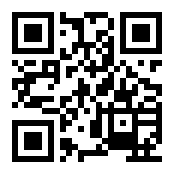Playing around with QR code generation and URL shortening…
I have tev.net, which is a pretty damn short domain, but just to be a *little* shorter, I registered tev.bz and set up YOURLS, an open-source URL shortener.
Here’s an example, I shortened a URL, from http://www.linkedin.com/in/tevkaber to http://tev.bz/3 and then generated this QR code image containing the shortened URL:

If you’re not familiar with QR codes, it’s basically a type of barcode.
A barcode is 1-dimensional, a series of bars of varying length. Although they have vertical height, it’s the same 1-dimensional data just stretched to make scanning possible. The most common barcode you’d be familiar with are product UPC codes, but there are many types.
A QR code is a 2-dimensional barcode. It can’t be read by an old 1D barcode reader, although many systems have been updated to read 2D barcodes. UPS and other shipping companies were some of the first places to use 2D barcodes.
Old 1D barcodes are just letters and numbers. New 2D barcodes are still just letters and numbers, but can contain more of them. So a 2D QR code can contain, for example, a URL, or someone’s contact info. The more text a QR code contains, the larger it is, which is why URL shorteners are typically used, to keep the QR code small so it doesn’t take up too much room on a page or label.
An emerging use of QR codes is in marketing. The idea is, rather than type in a long URL from a print ad, the user can scan the QR code from their smartphone. Most people have cellphones, most cellphones have cameras, and an increasing number are smartphones capable of displaying a website.
The problem is, the average person has no idea what a QR code is. On Android smartphones, QR code software comes bundled, but on iPhone the user would have to install a free app. The overall process of scanning and using a QR code has to be quick and easy, and while it’s not difficult, it’s not immediately obvious to the majority of users.
The common use of QR codes by consumers will either take off, or drift into obscurity like the ill-fated cueCat.